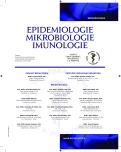Dengue Fever Cases in Czech Workers Returning from the Maldives
Authors:
Trojánek Milan 1,2; Tomíčková Dora 2; Roháčová Hana 1,2; Kosina Pavel 3; Gebouský Jan 3; Dvořák Jan 4; Chmelík Václav 5; Batistová Květoslava 6; Husa Petr 7; Maixner Jan 8; Sojková Naděžda 8; Zelená Hana 9; Marešová Vilma 1,2; Stejskal František 1
Authors‘ workplace:
1. infekční klinika, 2. lékařská fakulta, Univerzita Karlova v Praze a Nemocnice Na Bulovce, Praha
1; Klinika infekčních, tropických a parazitárních nemocí, Nemocnice Na Bulovce, Praha
2; Klinika infekčních nemocí, Lékařská fakulta v Hradci Králové, Univerzita Karlova v Praze a Fakultní nemocnice v Hradci Králové
3; Interní klinika, 2. lékařská fakulta, Univerzita Karlova v Praze a Fakultní nemocnice Motol
4; Infekční oddělení, Nemocnice České Budějovice, a. s.
5; Infekční ambulance, Oblastní nemocnice Písek
6; Infekční klinika, Lékařská fakulta, Masarykova univerzita a Fakultní nemocnice Brno
7; Oddělení virologie, Zdravotní ústav se sídlem v Ústí nad Labem, Praha
8; Národní referenční laboratoř pro arbovirózy, Zdravotní ústav se sídlem v Ostravě
9; Ústav imunologie a mikrobiologie, 1. lékařská fakulta, Univerzita Karlova v Praze a Všeobecná fakultní nemocnice
10; Infekční oddělení, Krajská nemocnice Liberec, a. s.
11
Published in:
Epidemiol. Mikrobiol. Imunol. 62, 2013, č. 3, s. 100-105
Overview
Aim:
The objective of this study is to present epidemiological characteristics and clinical symptoms of dengue fever cases in Czech workers who acquired the infection while working on the island of Fushivelavaru, Maldives. Furthermore, the study compares the sensitivity of novel direct detection assays, i.e. Real-Time Polymerase Chain Reaction (RT-PCR) and detection of Dengue NS1 antigen.
Material and Methods:
The retrospective study evaluated the clinical course of dengue fever cases in Czech workers returning from a job in the Maldives who were diagnosed with dengue virus infection from September 1 to October 31, 2012. The laboratory diagnosis of dengue fever was based on the serological detection of IgM and IgG antibodies, detection of dengue NS1 antigen by enzyme-linked immunosobent assay (ELISA), and detection of dengue virus DNA by RT-PCR.
Results:
The infection with dengue virus was confirmed in 18 males with a median age of 40 years (IQR 36-47) who returned from a job in the Maldives. Only one patient required admission to the hospital while the others were treated on an outpatient basis. The most frequently observed symptoms were fever (18), headache (9), muscle and joint pain (8 and 7, respectively), and rash (9). Typical laboratory findings were leukocytopenia and thrombocytopenia, a low CRP level, and elevated aminotransferase activity. The clinical course was uncomplicated in all patients. The dengue NS1 antigen detection (positive in all 10 patients with acute dengue fever) showed significantly higher sensitivity than the detection of viral RNA using RT-PCR (positive in 4 patients), p = 0.011.
Conclusion:
Although the vast majority of dengue fever cases are diagnosed among travellers returning from the tropics, the presented study points out the risks posed by dengue fever to long-term workers in endemic areas. The infection in the serologically naïve hosts is usually uncomplicated; however, infected persons are at significant risk of developing a severe complicated clinical course if challenged by another serotype. Furthermore, sick leaves or premature departures cause a considerable economic burden to employers. In the diagnosis of acute dengue fever, preference should be given to highly sensitive and specific tests for the direct detection of dengue virus (NS1 antigen and RT-PCR assays).
Keywords:
dengue – flaviviruses – imported infections – fever
Sources
1. World Health Organisation. Dengue: guidelines for diagnosis, treatment, prevention and Control. New ed. Geneva: WHO Press, 2009, 160 p., ISBN 978-924-154787-1.
2. Guzman, A. et al. Update on the global spread of dengue. Int. J. Antimicrob. Agents, 2010, 36, p. S40–42.
3. Jelinek, T. Trends in the epidemiology of dengue fever and their relevance for importation to Europe. Euro Surveill., 2009, 14, p. 1–3.
4. Halstead, S. B. Dengue. Lancet, 2007, 370, p. 1644–1652.
5. Whitehorn, J. et al. The pathogenesis of dengue. Vaccine, 2011, 29, p. 7221–7228.
6. Domingo, C. et al. Molecular and serologic markers of acute dengue infection in naive and flavivirus-vaccinated travelers. Diagn. Microbiol. Infect Dis., 2009, 65, p. 42–48.
7. Teles, F. R. et al. Trends in dengue diagnosis. Rev. Med. Virol., 2005, 15, p. 287–302.
8. International Federation of Red Cross. DREF Operation MDRMV001 Maldives Dengue Outbreak. [on-line]. c2011[cit.2013-04-18]. Dostupné na www: <http://reliefweb.int/sites/reliefweb.int/files/resources/MDRMV001do.pdf>
9. Oishi, K. et al. Dengue illness: clinical features and pathogenesis. J. Infect. Chemother., 2007, 13, p. 125–133.
10. Wichmann, O. et al. Clinical features and pitfalls in the laboratory diagnosis of dengue in travellers. BMC Infect Dis., 2006, 6, p. 120–128.
11. Kumarasamy, V. et al. Evaluating the sensitivity of a commercial dengue NS1 antigen-capture ELISA for early diagnosis of acute dengue virus infection. Singapore Med. J., 2007, 48, p. 669–673.
Labels
Hygiene and epidemiology Medical virology Clinical microbiologyArticle was published in
Epidemiology, Microbiology, Immunology

2013 Issue 3
Most read in this issue
- Diagnosis of Whooping Cough by Serology and Real-Time PCR
- Treponema pallidum subspecies pallidum – the Causative Agent of Neurosyphilis
- Prevalence of selected congenital anomalies in the Czech Republic: renal and cardiac anomalies and congenital chromosomal aberrations
- Dengue Fever Cases in Czech Workers Returning from the Maldives
